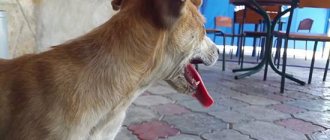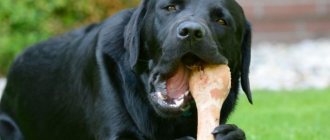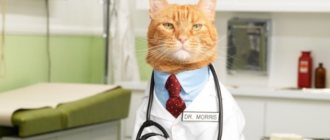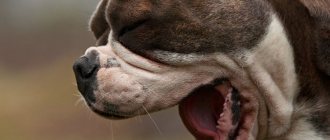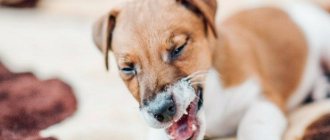In this article I will tell you why dogs can grunt. I will describe the main reasons for this phenomenon, such as natural location, entry of a foreign body into the nasal passage, neoplasms, parasites, tracheal collapse, paroxysmal breathing. I will explain what to do when a dog grunts.
Why does the dog grunt?
A dog that makes sounds like grunting is a clear symptom of one of the internal diseases and cannot be ignored. More often this is associated with pathologies of the heart, blood vessels and respiratory organs. This is especially true for decorative breeds with clear signs of inbreeding, which are prone to reverse sneezing and tracheal collapse. Grunting is a familiar sound for brachycephalic pets, but it also means that the dog needs to be taken to the veterinarian twice a year for a preventive examination.
Prevention
Any disease is easier to prevent than to cure. Therefore, keep an eye on your pet.
Treatment brings a lot of problems, not only physical, material, but also temporary. Some diseases can be treated within a month, while others cannot be completely cured until the end of the pet’s life.
Follow the general recommendations for the care and maintenance of your Spitz, and there will be no problems with its health.
Regular inspection
Regular periodic examination is mandatory for the presence of various signs that characterize the health of the pet:
Fluffy puppy
- mucous membranes;
- skin;
- wool;
- general activity and motor skills.
Important ! If at least one of the indicators is abnormal, contact your veterinarian.
Visit to the veterinarian
Periodically take your baby to the veterinarian for examination. Preventive diagnostics should be regular so that the disease can be recognized at an early stage.
At the veterinary clinic
You should visit the veterinary hospital at least twice a year, and preferably once every season.
TOP 6 causes of grunting sounds in dogs
Why does the dog grunt? This is not a typical sound for canines, so it almost always indicates a pathology, the severity of which only a doctor can understand. The list of possible and frequently diagnosed causes of a grunting sound includes:
- Foreign body in the nasal sinuses.
- Tracheal collapse (often diagnosed in Pugs, Yorkies, Spitz).
- Polyps and tumors in the respiratory tract.
- Aviary cough.
- Reverse sneezing.
- Pharyngitis.
A characteristic symptom when a dog is choking and , at the same time, grunting with its nose indicates heart failure. Often a specific symptom appears during an epileptic seizure.
Main causes of difficulty breathing
A dog grunts for several reasons. Sometimes this does not cause problems and does not affect the pet’s quality of life. Often, a similar symptom appears during allergic reactions. At the same time, the animal’s eyes water, they may turn red, the dog sneezes and grunts. This is how he may react to the bites of certain insects or to changes in diet. In some cases, breathing difficulties are a symptom of dangerous diseases.
Reverse sneezing
Why is the kitten shaking as if he is cold?
Reverse sneezing usually occurs in dogs with a shortened muzzle. This is one of the characteristics of breeds that is associated with spasms of the tissues of the soft palate.
Note! Veterinarians say that there is no need to panic in such cases, especially if the attack lasts only a few seconds, and after that the dog returns to normal life.
To help the animal come to its senses, you need to remember simple rules that will relieve the attack:
- you need to gently rub your nose;
- Slowly and gently massage the surface of the throat.
After the attack is over, you need to give your pet warm water.
The dog drinks water
Tracheal collapse
When the trachea collapses, it undergoes a sharp and severe narrowing. It may be that there is practically no gap left, and the animal will begin to suffocate. Before this, it will wheeze, grunt and make sounds reminiscent of quacking. Do not hesitate to contact a doctor; your dog may need to be intubated by inserting a tube into the trachea. Sometimes this is the only way to improve breathing and save your pet’s life. Only specialists can provide emergency assistance.
Important! In any case, if the animal breathes only through its mouth and wheezes, and its mucous membranes have turned blue, there is no need to hesitate. The dog may fall into a coma, and even if he is saved, this episode will affect his health in the future.
Paroxysmal breathing
Paroxysmal, or reverse, breathing is observed exclusively in male dogs. An attack when a dog wheezes, grunts and seems to be suffocating, frightens the owners, because strange sounds are not the only thing that changes in the animal’s behavior:
- the dog spreads its paws wide and at the same time strongly arches its back;
- his muzzle takes on a terrifying expression, his eyes turn red;
- he begins to vigorously shake his head from side to side, so that drool flies everywhere.
This condition is dangerous because the dog inhales the air forcefully, it irritates the palate and this can provoke vomiting. At this time, the animal grunts, drawing the contents of the oral cavity back. This can cause vomit to enter the lungs, leading to pneumonia.
Parasite infestation
Worms live not only in the intestines; some species prefer to settle in the lungs. They cling to the walls, injuring the mucous membrane, destroying the bronchi. After the parasites begin their activity, they secrete substances that damage tissue. As a result, the animal begins to cough. This further irritates the organ mucosa, and the condition worsens. The dog is breathing with difficulty, gurgling and grunting can be heard.
Note! If you do not get rid of parasites, they can lead to poisoning of the body. If left untreated, your pet may suffocate.
Heart problems
A dog that grunts may be suffering from heart failure. This is usually typical for older animals. They are constantly thirsty and walk around with their tongue hanging out, which looks quite pale. The animal's gait changes; it reflexively spreads its paws wide. Often the dog is tormented by a cough, the attacks of which are quite long.
The dog is coughing
During a heart attack, your dog doesn't just breathe heavily, he begins to wheeze. In this condition, she must be quickly taken to the clinic.
Pulmonary edema
Pulmonary edema can be caused by infectious diseases, as well as heart failure. At the same time, the dog makes sounds that are unusual for it, wheezes, and has shortness of breath. The tongue and gums become noticeably pale, and the animal is bothered by a dry cough.
Important! Until the dog receives help from specialists, you need to monitor his breathing and remove drool so that he does not choke.
Tumors
When a tumor occurs in the nose, the following symptoms appear:
- grunting develops into a cough, which develops gradually, intensifies and does not go away;
- the animal becomes lethargic, inactive, loses its appetite, and loses weight;
- I'm worried about a runny nose, traces of blood are found in the discharge.
The presence of such signs requires contacting an animal medical clinic.
Tracheal collapse
The etiology of the disease has not been fully studied; it is diagnosed in small breeds of dogs under the age of 2 years. Characteristic symptoms of collapse that you need to pay attention to:
- Dyspnea.
- Convulsive inhalation (“swallowing” of air).
- Cyanosis (blue discoloration) of mucous membranes and tongue.
- Nose grunting.
Due to a critical lack of oxygen, fainting and loss of coordination of movement are common. The dog becomes apathetic and stops playing. Collapse is dangerous in combination with dilated cardiomyopathy, when the parts of the heart are increased in volume.
If tracheal collapse is suspected, an X-ray examination is performed, pictures are taken during inhalation and exhalation. Tracheoscopy is considered a “talking” study, so the diagnosis can be made with 100% accuracy, but there are certain risks when administering anesthesia.
Treatment is surgical; tracheal stenting is indicated. Medicines are prescribed to relieve severe symptoms and ease breathing.
Yorkshire eye diseases
*We will partially answer the questions of what to do if your Yorkie’s eyes are festering or running .
Yorkies have been shown to have a predisposition to several retinal pathologies.
As a rule, these are hereditary things:
- spontaneous detachment;
- degeneration (when retinal cells die);
- dysplasia (when the retina develops abnormally).
What to do : if your Yorkshire Terrier's vision in the dark has become worse, his pupils do not constrict even in the light, or the fundus of the eye is slightly glowing gray, run to the doctor.
Dry eye is another problem for Yorkies.
The lack of fluid is provoked by a genetic disorder of the lacrimal system, in which the lacrimal canals narrow or become completely impassable.
Due to delayed outflow, the lacrimal gland often becomes inflamed. And insufficient moisture can affect the cornea or conjunctiva.
Cataracts - white and glaucoma - green clouding of the eyes of Yoriki are usually obtained from their owners; Sound scary? And they get it in the literal sense: with shampoo or a comb in the eye.
What to do : Gently groom your Yorkie's coat on his head and face. For any eye pathologies, go to a veterinary hospital.
Foreign body
If the dog grunts its nose and behaves as if it is choking, there is a suspicion that a foreign body is stuck in the nasal sinuses and larynx area. Particularly dangerous are bone fragments that scratch and damage the mucous membrane of the larynx with each swallow. On the list of dangerous:
- Nails.
- Needles.
- Glass.
- Small items from children's construction sets, etc.
Difficulty breathing, poor natural passage of air, causes the dog to swallow, strain and inhale convulsively. With a lack of oxygen, visible mucous membranes turn blue, the inside of the cheeks, gums and tongue become cyanotic.
Diagnostics: X-ray. If a foreign body is detected, surgery is performed and the object causing breathing difficulties is removed.
Parasite infestation
There is a common belief that parasitic worms exclusively affect the gastrointestinal tract, but this is far from the truth. Although the intestines are indeed a favorite place for worms, there are several types of worms that prefer to live in the lungs.
As the colony of worms increases, the breathing of the dog, especially the puppy, will worsen, since the circulation of air masses is inadequate. Again, the danger lies not in grunting or hissing, but in the fact that there have been cases where puppies died, literally suffocating. With progressive helminthic infestation, there is a risk that all offspring will die!
In addition, there are certain types of parasites from the group of nematodes, which spend one of their life cycles in the lungs. In this organ, young individuals receive adequate nutrition for intensive growth and remain here until they grow up. Then they move to the intestines, where their “adult life” begins, followed by reproduction.
While the parasite larvae are in the tissues of the lungs, they injure the organ - the alveoli and bronchi. In addition, after a week and a half, nematodes begin to synthesize specific substances that irritate the mucous surfaces of the respiratory system. This leads to the development of intense coughing and sneezing, and in young animals these signs manifest themselves more actively.
When the dog breathes, gurgling, wheezing sounds are heard, he begins to grunt, sniffle, trying to push air into the lungs with irritated and inflamed walls. If the helminthic infestation has developed to such a clinical picture, a doctor’s consultation is required, since if there is any delay, the dog will develop pneumonia or severe bronchial inflammation.
Reverse sneezing
This sign is more common in dogs of dwarf breeds with a long, narrow muzzle (toy poodle). Outwardly, it looks as if the pet has got something in its nose and is frantically trying to sneeze it out. At the same time, he draws in air and makes grunting sounds, coupled with shortness of breath and noisy breathing.
More often than not, this is not a dangerous symptom. It is necessary to do an ECHO, X-ray and exclude tracheal collapse and heart failure. The attack is short-lived, a maximum of 10 minutes; if you massage the back of the nose, it stops, the dog calms down and stops grunting.
The reasons for this phenomenon have not been studied; there is an assumption that this is due to a certain type of structure of the larynx, as well as dust and pollen entering the nasopharynx. There is no treatment.
Treatment
If the dog's intense breathing is not associated with external factors, you should definitely contact a veterinary clinic. Once the reason why the dog is choking is established, treatment is prescribed. However, shortness of breath is a symptom that in itself is dangerous; Hypoxia may occur with unpredictable consequences. If there is a threat of oxygen starvation, oxygen therapy may be indicated for a sick animal - inhalation of a special gas mixture with a high oxygen content. For infectious diseases and acute inflammatory processes, antibiotics and anti-inflammatory drugs are given.
Article read by 4,155 pet owners Breathing problems are more common in dogs than in cats. You can tell that your pet is choking by its open mouth, shallow, quick breaths, and sometimes by a hanging tongue.
The main method of cooling a dog's body is the method of cooling through evaporation through the evaporation of moisture from the surfaces of the mucous membranes of the upper respiratory tract. Under normal conditions, the pet takes 30-40 breaths per minute, and at high ambient temperatures, 300-400 breaths per minute.
[custom_ads_shortcode2]
Neoplasms of various origins
Tumors in the nasopharynx are diagnosed more often in dogs after 7-8 years of age and cause a specific sound reminiscent of grunting. The first signs appear suddenly in the form of shortness of breath or difficulty swallowing. The faster the tumor grows, the stronger the symptoms; it becomes difficult for the pet to eat and breathe, especially during physical exertion; he tries to “cough up” and remove the interfering tumor.
Carcinomas are found in the larynx, polyps and sarcomas are found in the nose. Favorable prognosis for polyps. If they are detected in a timely manner, surgery is performed and removed. With sarcomas and carcinomas, everything depends on the stage of the pathological process and the degree of tumor penetration into healthy tissue. In case of metastasis to other organs, surgical treatment is not justified.
Other diseases of Yorkshire terriers
Allergies in Yorkies : symptoms and treatment.
This breed is “famous” for its tendency to allergies: hereditary and acquired.
Read as pathological sensitivity to several substances:
pollen - seasonal allergies (during flowering plants); with it, the mucous membranes of the eyes are irritated and the mucous membranes of the nose are inflamed; medications - in addition to the skin form, it can result in anaphylactic shock; products are all individual, but Yorkies are very sensitive to all sorts of vegetable and fruit delights. In addition to food allergies, the skin may be damaged; washing/detergent/cosmetic products , plus parasites (mosquitoes, fleas and others) - such an allergy is expressed by hives. That, in turn, causes “wandering” skin redness.
What to do : Doctors do not advise treating dog allergies on your own and do not welcome any cheap miracle remedies without a prescription.
Inflammation is one of the skin problems of Yorkshire Terriers. It is expressed by dermatitis (swelling), which can become wet; high temperature.
Alopecia is another skin condition in Yorkies that causes hair to suddenly fall out (mostly on the head and about the size of a coin).
Cryptorchidism is a disease in which one or both testicles do not descend into the scrotum.
Distichiasis is when your Yorkie grows extra eyelashes behind the “normal” ones.
In terms of health, the Yorkshire Terrier should be considered as a sick child versus a healthy one. Of course, this means all small dog breeds. You yourself understand that there is a difference: a Caucasian in a draft or a Yorkie in the same draft. Therefore, take care of your little ones. Be sure to dress him in the cold season, feed him properly, don’t let him jump from a height and just love him madly - sometimes this is enough.
* Why partially? Please remember that no article, no thematic forum, or even an online consultation with a veterinarian will give the same result as a normal examination of an animal in a clinic by a good doctor. If you see that your Yorkshire Terrier, Great Dane, or Nile crocodile is not feeling well, go to the doctor. To a proven, real aibolit.
Yes, I know this is the hardest thing. The most important thing for us is what we have in the lives of our beloved pets. If you've been through this, you know what I'm talking about. And therefore, having poked around veterinarians, listened to everyone, read reviews, visited clinics and lost my Scottish son Tikhon, I will tell you: firstly, not even the coolest doctor in the coolest clinic will give you any guarantees. That is, he will, of course, because you want to hear that “everything will be fine.” But no one ever knows what will really happen. How your animal’s body will react to anything or with whom your doctor will change shifts for half an hour, missing the attack of a small patient. I want to say that be prepared for anything, but believe, sincerely, with all your heart, believe in the best and wish for it.
Secondly, prepare yourself. This may sound scary, but I would like to read something like this in due time: if you do not study all the media available to you, do not communicate in veterinary queues, do not change doctors a thousand times, or - what else needs to be done to save the life of your soul mate in a dying body? - you will definitely regret it. Do your best, it's within your power. No, it's your responsibility.
Source: kotovasia.net
Infectious tracheobronchitis
Another name is kennel cough, a respiratory disease in dogs that occurs in an acute form. Pathology provocateurs are a complex of bacterial and viral pathogens.
The disease becomes widespread in nurseries, packs of stray dogs, shelters, and anywhere where sanitary standards for keeping pets are not observed.
The main symptoms resemble pharyngitis, bronchitis, the dog coughs in fits and starts, grunts through its nose, there is discharge from the eyes and nose, and the regional lymph nodes are enlarged.
Aviary cough with a strong pet’s immunity and timely transfer to good housing, feeding occurs on its own. With the development of secondary infections and non-compliance with hygiene rules in the premises, death is possible.
How to treat
If you notice that your pet has begun to breathe heavily, sneeze and cough, do not leave things to chance, take action and contact a veterinarian.
A cold cough lasts only 2-3 days and goes away on its own. There is no need to treat it; it can harm the health of the animal.
Important ! Do not mindlessly give “human” coughing and expectorant medications to a sick animal. Without knowing the dosage, you can cause an allergic reaction and other side effects.
It should be understood that coughing is only a symptom that can only be correctly interpreted after a complete examination of the dog.
Have your dog checked regularly by a veterinarian
If the animal coughs for 2-3 days, wait; if the condition worsens, go to the veterinary clinic immediately.
Anatomy and breed specifics
Almost all owners of brachycephalic dogs claim that their pet makes “indecent” sounds, sniffles, grunts and snores. This is explained by the specific structure of the pharynx, the soft palate, which, over the course of life, relaxes and falls down, blocking the natural flow of air. Due to selection and reduction in the volume of the skull bones, soft “excess” tissues are collected in folds not only outside (Shar Pei), but also inside. This is inherent:
- French and English bulldogs.
- Pugs.
- Shar Pei.
- Japanese Chin.
Pomeranians and Yorkies are also characterized by similar grunting sounds, although they have a rather elongated and miniature muzzle. The sound increases during physical activity, after 5 years (weakening of tissues), during heat, and excitement. With the development of brachycephalic syndrome, shortness of breath, snoring and grunting sounds occur even when the pet is completely at rest.
Yorkshire Terrier ears
Ear diseases are always difficult for humans, let alone small Yorkies.
With their increased sensitivity, a draft is enough and inflammation of the middle ear is guaranteed.
What to do : dress your dog warmly for walks, dry it thoroughly and comb out the coat after any wetness. Don't keep your Yorkie in warm conditions - harden it: take regular and active walks in windless, not very cold weather. Be wary if your Yorkie scratches his ears or shakes his head strangely. Monitor ear odor and discharge. And don't self-medicate.
Another common problem is ear mites, which small Yorkies are more susceptible to than larger dogs.
What to do : get a vaccine for prevention, go to a clinic for treatment.
